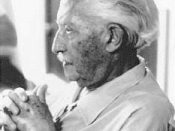When looking at the psychodynamic theory you will notice Erik Erikson's stage theories which include adolescence to adulthood, early adulthood, middle adulthood, and lastly late adulthood. This paper will look into this theorists' beliefs and how these theories apply to the various aspects of eating behaviors.
In Erikson's first stage, the oral-sensory stage, the basic crisis centers on the development of either trust or mistrust. An infant is almost completely dependent on others for the fulfillment of his needs. If these needs are consistently satisfied and if it receives love and stimulation with those that it comes in contact with, it will develop a sense of trust, not only in others but in itself and in its ability to handle its needs (Fletcher, 2007). Healthy feeding behavior begins at infancy, as infants and their caregivers establish a partnership in which they recognize and interpret both verbal and non-verbal communications from each other.
If the child does not receive consistent, responsive interactions, the attachment bond may not be secure, and feeding may become an occasion for unproductive battles over food (Black, 2007).
Erikson's second stage, Autonomy vs. shame and doubt, is a theory of psychosocial development takes place during early childhood and is focused on children developing a greater sense of personal control. Other important events include gaining more control over food choices, toy preferences, and clothing selection (Wagner, 2005).Toddler hood is characterized by bids for autonomy and independence as children strive to do things for themselves. When this is applied to eating, children my be hesitant to try new foods and insist on limiting the repertoire of foods leading them to be described as picky eaters. Caregivers should be introducing new foods to the child during this time, introducing new foods for the child to experience (Black, 2007).


